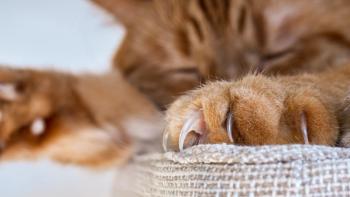
Surgery STAT: Don't forget the Miller's knot
Ligating the ovarian pedicles during an ovariohysterectomy in a large or obese dog can be a challenging task, especially if the ovarian pedicles are thick or surrounded by excessive adipose tissue that is not easily incorporated into simple encircling ligatures.
Ligating the ovarian pedicles during an ovariohysterectomy in a large or obese dog can be a challenging task, especially if the ovarian pedicles are thick or surrounded by excessive adipose tissue that is not easily incorporated into simple encircling ligatures.
Robert J. Hardie, DVM, Dipl. ACVS, Dipl. ECVS
A helpful technique that can improve the security of ligatures placed in these situations is to use a "friction" or "binding" type knot. These types of knots are more secure than simple encircling ligatures because of the increased friction and greater surface area of compression created by the loops that encircle the pedicle.
Examples of binding knots include the Miller's knot, the modified Miller's knot or strangle knot and the constrictor knot. These types of knots originally were used by workers in the milling industry (hence the name Miller's knot) because of the added security they provided for tying and storing large bags of grain.
The Miller's knot is created by passing a length of suture material around a clamped pedicle twice to create two loops, with the second loop overlapping the first. The free end of the suture is then passed under and over the first loop to create the first throw of the knot (Photo 1). Both free ends are then pulled in opposite directions, ensuring that both loops are tightened evenly and that the pedicle is thoroughly compressed. The Miller's knot is then finished with a series of square knots to prevent loosening.
Photo 1: Miller's knot
The modified Miller's knot (strangle knot) is similar to the Miller's knot and is created by passing a strand of suture material around a clamped pedicle twice to create two loops, but without overlapping the loops. The free end of the suture is then passed over and under both loops to create the first throw of the knot. Both free ends are then tightened evenly as previously described and finished with a series of square knots to prevent loosening (Photo 2).
Photo 2: Modified Miller's knot
Both knots can be performed using either hand or instrument tie technique; however, when tightening the knot, it is important to make sure that both loops tighten evenly and that there is no slack in the loops to ensure that the pedicle is completely compressed.
The type of suture material used and the coefficient of friction that it has may affect how easily the loops slide over each other, so it is important to be familiar with the handling properties of the suture material when using these knots.
The modified Miller's knot is technically easier to perform than the Miller's knot because it is not necessary to overlap the two loops when passing the suture around the pedicle, and also the free end of the suture is passed over and under both loops rather than between loops, thereby requiring less manipulation to complete the knot.
At the University of Wisconsin, we actively promote the modified Miller's knot in our surgical training courses and feel that it is a very valuable technique to use when ligating challenging vascular pedicles.
Dr. Hardie is a board-certified surgeon through the American College of Veterinary Surgeons (ACVS) and European College of Veterinary Surgeons (ECVS). He is clinical associate professor of Small Animal Soft Tissue Surgery at the University of Wisconsin's School of Veterinary Medicine.
Newsletter
From exam room tips to practice management insights, get trusted veterinary news delivered straight to your inbox—subscribe to dvm360.





